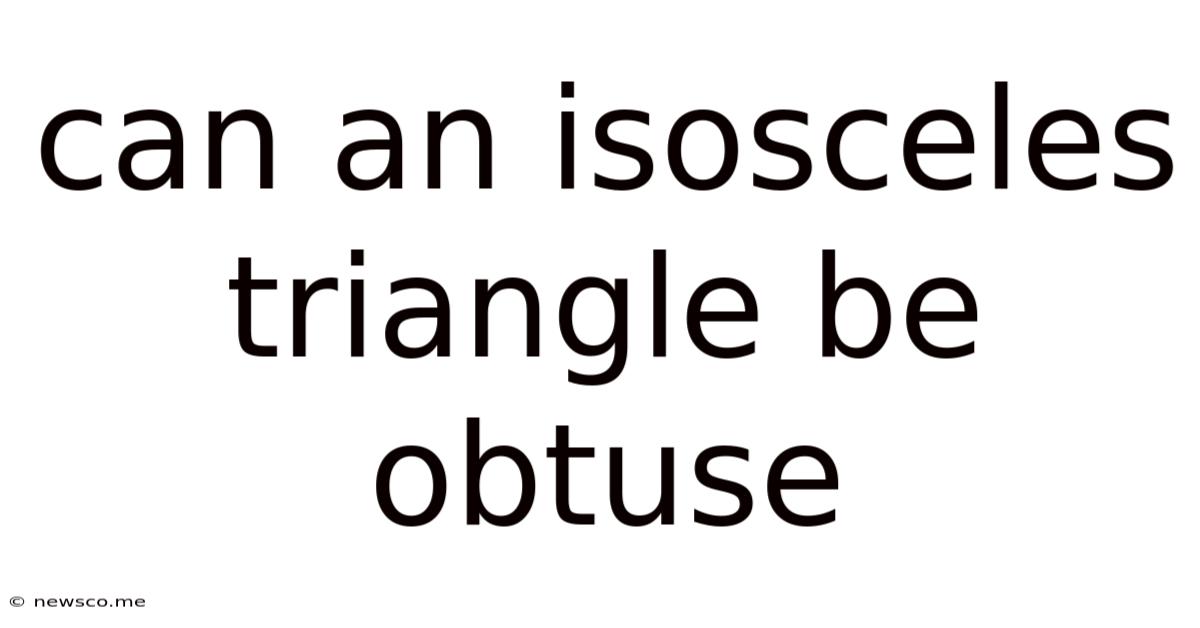Can An Isosceles Triangle Be Obtuse
News Co
Mar 16, 2025 · 5 min read

Table of Contents
Can an Isosceles Triangle Be Obtuse? Unraveling the Geometry
The question of whether an isosceles triangle can be obtuse sparks curiosity in the world of geometry. Understanding the properties of triangles, especially the interplay between their angles and side lengths, is crucial to answering this question definitively. This comprehensive exploration will delve into the definition of isosceles and obtuse triangles, analyze their properties, and definitively answer the central question, providing examples and explanations along the way.
Defining Key Terms: Isosceles and Obtuse Triangles
Before diving into the core question, let's clearly define the types of triangles involved:
Isosceles Triangle: An isosceles triangle is defined by having at least two sides of equal length. These equal sides are called the legs, and the third side is called the base. Importantly, the angles opposite the equal sides (the base angles) are also equal. This property is fundamental to many proofs and applications involving isosceles triangles.
Obtuse Triangle: An obtuse triangle is characterized by having one angle that measures greater than 90 degrees (but less than 180 degrees). This angle is called the obtuse angle. The other two angles in an obtuse triangle must be acute angles (less than 90 degrees).
The Sum of Angles in a Triangle: A Fundamental Principle
A crucial concept in understanding triangle properties is the fact that the sum of the interior angles of any triangle always equals 180 degrees. This principle forms the foundation for many geometric proofs and calculations. Knowing this, we can analyze the possibilities for angles within both isosceles and obtuse triangles.
Can an Isosceles Triangle Be Obtuse? A Step-by-Step Analysis
Now, let's address the central question: Can an isosceles triangle be obtuse? The answer is a resounding yes. Here's why:
Consider an isosceles triangle with two equal sides. Let's denote the angles opposite these sides as 'x'. The third angle, the angle opposite the unequal side, is denoted as 'y'. Because it's an isosceles triangle, we know that x + x + y = 180° (sum of interior angles). This simplifies to 2x + y = 180°.
For the triangle to be obtuse, one of its angles must be greater than 90°. If we let 'y' be the obtuse angle, then y > 90°. Substituting this into our equation, we have:
2x + y > 2x + 90°
Since 2x + y = 180°, we can see that:
180° > 2x + 90°
Subtracting 90° from both sides:
90° > 2x
Dividing by 2:
45° > x
This means that x (the base angles) must be less than 45 degrees. As long as the base angles are less than 45 degrees and the third angle is greater than 90 degrees, the sum of the angles remains 180 degrees.
Example: Constructing an Obtuse Isosceles Triangle
Let's create a specific example:
Let's set one of the base angles, x, to 30°. Since the triangle is isosceles, the other base angle is also 30°. The sum of the base angles is 60°. Therefore, the obtuse angle, y, must be 180° - 60° = 120°. This demonstrates that an isosceles triangle can have an obtuse angle.
Visual Representation
Imagine an isosceles triangle where the two equal sides are relatively long compared to the base. As you gradually increase the angle between the equal sides, you'll see it transition from acute to right-angled and finally to obtuse. This visual demonstration supports the mathematical analysis.
Exploring the Limits: Can an Isosceles Triangle Be Both Obtuse and Equilateral?
While an isosceles triangle can be obtuse, it's important to note that an isosceles triangle cannot be both obtuse and equilateral. An equilateral triangle has all three sides of equal length, and consequently, all three angles are equal at 60 degrees (an acute angle). Since an obtuse triangle requires one angle to be greater than 90 degrees, these properties are mutually exclusive.
Isosceles Triangles: A Broader Perspective
Isosceles triangles, both acute and obtuse, appear frequently in various mathematical and real-world applications. Their symmetrical nature lends itself to elegant geometric proofs and solutions. Understanding their properties is fundamental to numerous branches of mathematics, including geometry, trigonometry, and calculus.
Practical Applications of Isosceles Triangles
The principles of isosceles triangles extend beyond theoretical geometry. These shapes appear in many practical applications:
-
Architecture and Construction: Isosceles triangles are used in roof structures, bridge designs, and other construction projects to create stable and aesthetically pleasing structures.
-
Engineering: They find applications in engineering design, particularly in creating symmetrical and stable structures.
-
Art and Design: Isosceles triangles are employed in visual arts and graphic design to create balanced and visually appealing compositions.
-
Nature: Isosceles triangles can be found in natural formations, showcasing the universal principles of geometry in the world around us.
Conclusion: A Definitive Answer and Further Exploration
In conclusion, the answer to the question "Can an isosceles triangle be obtuse?" is definitively yes. The mathematical analysis, supported by examples, clearly shows that an isosceles triangle can possess one obtuse angle while maintaining its defining characteristic of having at least two sides of equal length. However, it cannot be both obtuse and equilateral simultaneously. Understanding the properties of different triangle types is crucial for many aspects of mathematics, science, and engineering. This exploration has not only answered the central question but also provided a broader perspective on the fascinating world of geometry and its practical applications. The interplay between angles and side lengths in triangles remains a rich area for further exploration and discovery.
Latest Posts
Related Post
Thank you for visiting our website which covers about Can An Isosceles Triangle Be Obtuse . We hope the information provided has been useful to you. Feel free to contact us if you have any questions or need further assistance. See you next time and don't miss to bookmark.